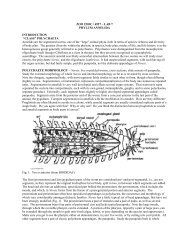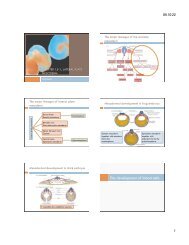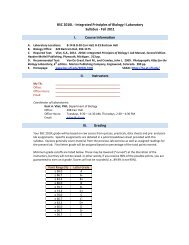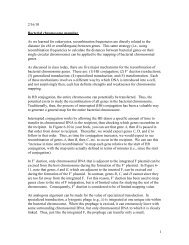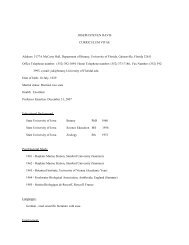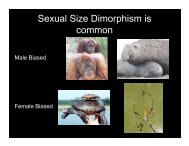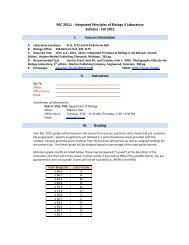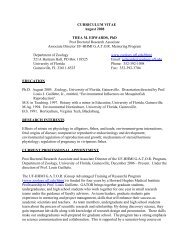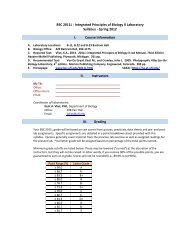Drift 2
Drift 2
Drift 2
Create successful ePaper yourself
Turn your PDF publications into a flip-book with our unique Google optimized e-Paper software.
6PLUS the frequency of A2 alleles (q) multiplied by the probability that an A2 mutates toan A1, which is v.We can write a recursion in terms of p 0 : p t = (v/u+v) + [p 0 - (v/u+v)](1-u-v) tTwo important points emerge from this recursion:1. When t is small, (1-u-v) t ≈ 1-t(u+v). If p 0 = 0, then p t ≈ tvSo, p increases linearly with time, but the rate is very slow because v is small2. As t→ ∞, (1-u-v) t → 0, so p^ = v/(u+v)III.B. Mutation and <strong>Drift</strong>- Mutation introduces new alleles into the population at rate 2Nu- <strong>Drift</strong> removes variation at rate 1/2N (JHG equation 2.1)Recall G, the probability that two alleles that are different by origin are identical by state.After one generation of random mating and mutation,G ' = (1-u) 2 [(1/2N) + (1-1/2N)G]To see why this is, note that Pr(1st allele didn't mutate) = 1-u, so Pr(neither allelemutated) = (1-u)(1-u) = (1-u) 2 .Now we can use three approximations of the sort that theoreticians love to use to baffleempiricists.1) (1-u) 2 ≈ 1-2u if u is small [because (1-u)(1-u) = 1-2u+u 2 and u 2 is really small]2) Ignore terms with u/N, because u is small and N is large, so u/N is really small3) Let H = 1-G and rearrange to get H ' ≈ (1-1/2N)H + 2u(1-H)So, ΔH = -(1/2N)H + 2u(1-H) JHG Equation 2.9At equilibrium ΔH = 0, so H^ = 4Nu/(1+4Nu)and G^ = 1/(1+4Nu)- We can express Equ'n 2.9 as: Δ N H + Δ u HNote that for a given H, Δ N H depends only on N and Δ u H depends only on u




